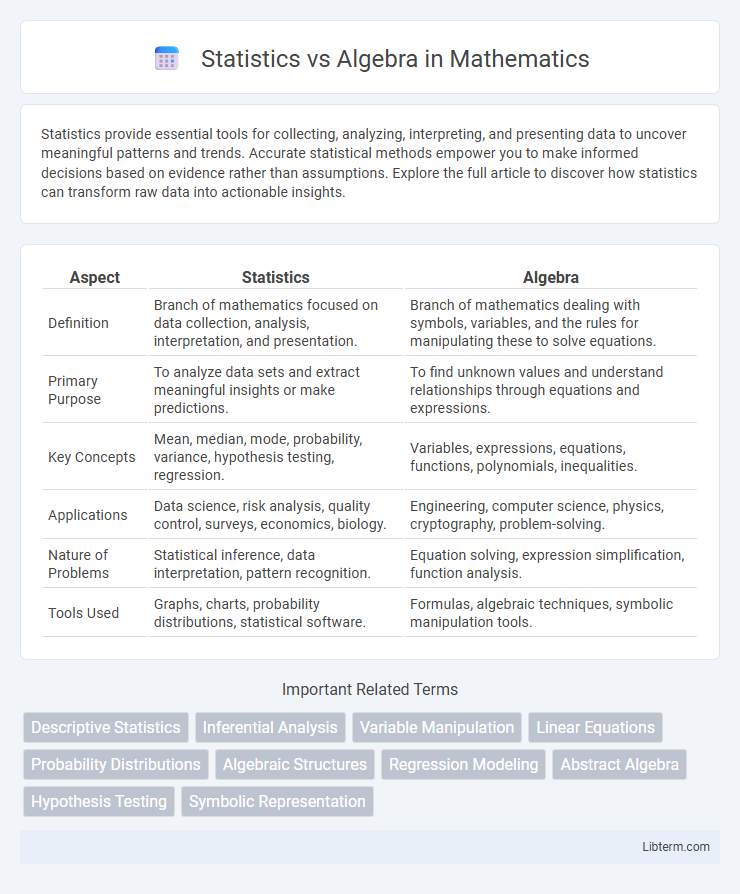Statistics provide essential tools for collecting, analyzing, interpreting, and presenting data to uncover meaningful patterns and trends. Accurate statistical methods empower you to make informed decisions based on evidence rather than assumptions. Explore the full article to discover how statistics can transform raw data into actionable insights.
Table of Comparison
| Aspect | Statistics | Algebra |
|---|---|---|
| Definition | Branch of mathematics focused on data collection, analysis, interpretation, and presentation. | Branch of mathematics dealing with symbols, variables, and the rules for manipulating these to solve equations. |
| Primary Purpose | To analyze data sets and extract meaningful insights or make predictions. | To find unknown values and understand relationships through equations and expressions. |
| Key Concepts | Mean, median, mode, probability, variance, hypothesis testing, regression. | Variables, expressions, equations, functions, polynomials, inequalities. |
| Applications | Data science, risk analysis, quality control, surveys, economics, biology. | Engineering, computer science, physics, cryptography, problem-solving. |
| Nature of Problems | Statistical inference, data interpretation, pattern recognition. | Equation solving, expression simplification, function analysis. |
| Tools Used | Graphs, charts, probability distributions, statistical software. | Formulas, algebraic techniques, symbolic manipulation tools. |
Introduction to Statistics and Algebra
Statistics studies data collection, analysis, interpretation, and presentation, providing tools to summarize information and make inferences. Algebra focuses on manipulating symbols and solving equations to find unknown values within mathematical expressions. Introduction to Statistics covers descriptive and inferential statistics, while Introduction to Algebra involves understanding variables, functions, and equations.
Core Definitions: Statistics vs Algebra
Statistics involves the collection, analysis, interpretation, and presentation of data to identify patterns and trends, focusing on measures such as mean, median, mode, variance, and probability. Algebra is a branch of mathematics centered on symbols and the rules for manipulating these symbols, including variables, equations, functions, and expressions. Understanding foundational concepts like data sets and statistical inference in statistics contrasts with mastering variables, linear equations, and polynomial functions in algebra.
Fundamental Concepts in Statistics
Statistics centers on data collection, analysis, interpretation, and presentation, emphasizing concepts like mean, median, mode, variance, and standard deviation for data summarization. Probability theory plays a crucial role in statistics, underpinning hypothesis testing and inferential methods that enable predictions about populations from samples. Unlike algebra's focus on abstract symbols and equations, fundamental statistical concepts ensure practical insights from real-world data patterns and variability.
Key Principles in Algebra
Algebra centers on understanding variables, expressions, equations, and functions, emphasizing the manipulation of symbols to solve mathematical problems. Key principles include the use of operations like addition, subtraction, multiplication, and division within equations, the application of the distributive property, and the solving of linear and quadratic equations. Mastery of algebraic concepts such as balancing equations and working with inequalities forms the foundation for advanced mathematics and analytical problem-solving skills.
Differences in Problem-Solving Approaches
Statistics emphasizes analyzing data sets to identify patterns, variability, and probabilities using tools like mean, variance, and hypothesis testing, focusing on interpreting real-world information. Algebra involves manipulating symbols and expressions to solve equations and understand relationships between variables through operations such as factoring, simplifying, and solving linear or quadratic equations. The problem-solving approach in statistics relies on data collection and inference, while algebra depends on abstract reasoning and formula manipulation for precise solutions.
Applications of Statistics in Real Life
Statistics plays a crucial role in real-life applications by enabling data analysis for informed decision-making across various fields such as healthcare, finance, marketing, and public policy. It helps in identifying trends, making predictions, and evaluating risks through techniques like hypothesis testing, regression analysis, and probability models. Unlike algebra, which focuses on abstract mathematical structures and solving equations, statistics emphasizes interpreting data to understand and solve real-world problems effectively.
Uses of Algebra in Everyday Scenarios
Algebra plays a crucial role in everyday scenarios such as budgeting by helping to formulate equations that represent income and expenses, enabling better financial planning. It is essential in cooking for adjusting ingredient quantities through proportional relationships and solving for unknown variables in recipes. Additionally, algebra assists in technology use, including programming and troubleshooting devices, by applying logical problem-solving methods and modeling real-world situations with variables.
Learning Curve: Which Is Harder?
Statistics often presents a steeper learning curve due to its reliance on interpreting data and probability concepts, which require abstract thinking and real-world application skills. Algebra, while foundational and involving complex problem-solving and symbol manipulation, offers more structured rules and formulas that can be systematically mastered. Learners typically find algebra more predictable in progression, whereas statistics demands adaptive reasoning and critical analysis, influencing perceived difficulty levels.
Career Paths: Statistician vs Algebraist
Career paths in statistics often lead to roles such as data scientist, biostatistician, or quantitative analyst, where expertise in data interpretation, probability, and statistical modeling is crucial. Algebraists typically pursue careers in academia or research, focusing on abstract mathematical theories, cryptography, or theoretical computer science. Statisticians apply their skills in industries like healthcare, finance, and government, while algebraists contribute to advancements in pure mathematics and algorithm development.
Conclusion: Choosing Between Statistics and Algebra
Choosing between statistics and algebra depends on the specific application and career goals; statistics is essential for data analysis, probability, and interpreting real-world trends, while algebra provides foundational skills for abstract problem-solving and mathematical modeling. Fields like data science, economics, and social sciences heavily rely on statistical methods, whereas engineering, computer science, and physics prioritize algebraic techniques. Understanding the core competencies of each discipline helps determine which mathematical approach best suits individual academic and professional needs.
Statistics Infographic

 libterm.com
libterm.com